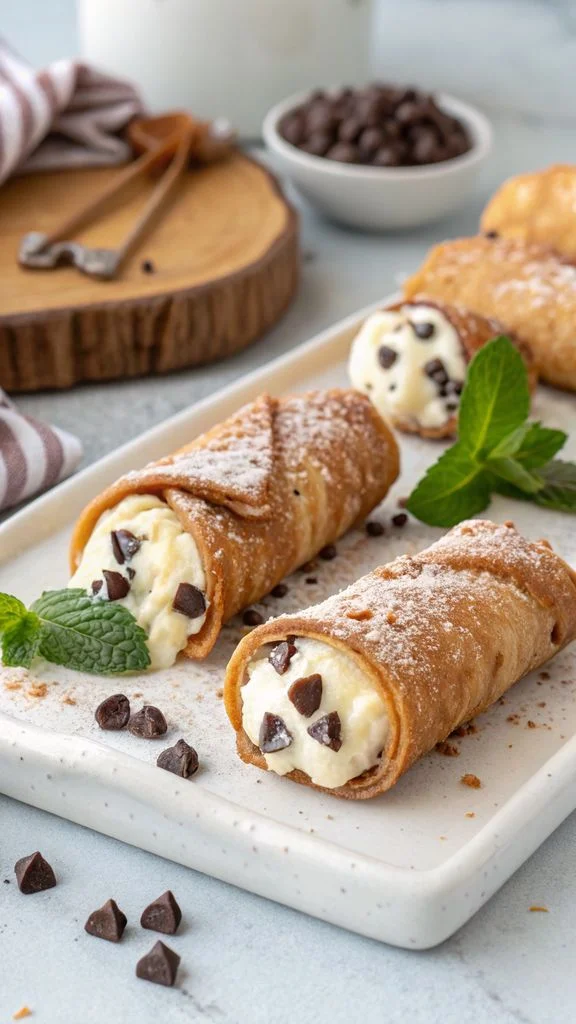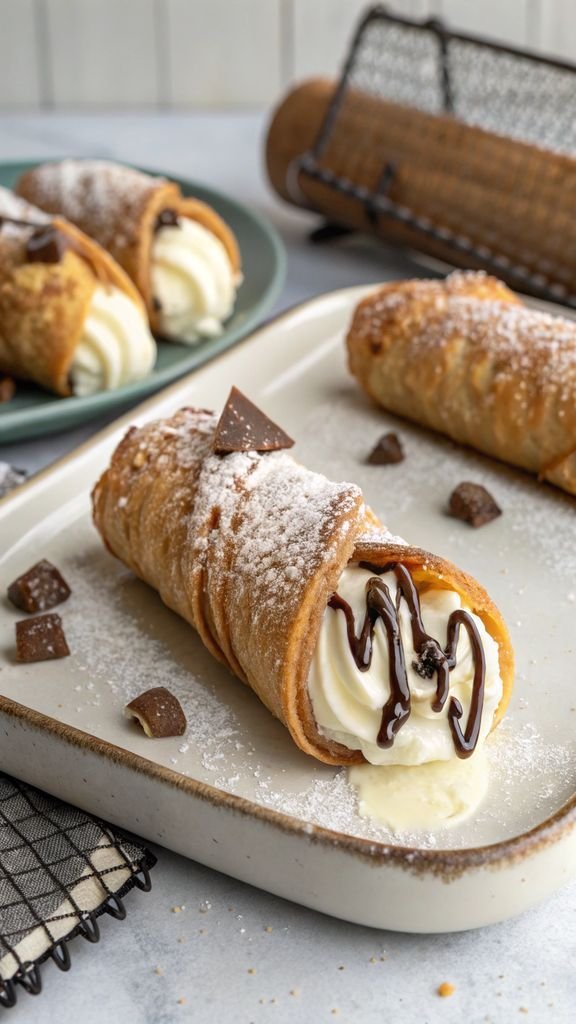Homemade Cannoli: Crispy Sicilian Tubes of Sweet Bliss
Introduction
Cannoli are more than just a dessert—they’re edible poetry from Sicily. Imagine golden, shatteringly crisp pastry tubes hugging clouds of sweetened ricotta, punctuated by chocolate chips and kissed with powdered sugar. My first encounter with authentic cannoli was in a tiny Palermo pasticceria, where the pastry chef handed me a freshly filled tube still warm from the fryer. That perfect balance of crunchy shell and luscious filling sparked my lifelong love affair with this iconic treat.

Originating in Sicily during the Arab rule (circa 1000 AD), cannoli were traditionally prepared for Carnevale celebrations as symbols of fertility and abundance. The name “cannoli” literally means “little tubes,” referencing the river reeds (canna) originally used to shape them. Immigrants brought this treasure to America, where it became a staple in Italian bakeries. What makes cannoli truly magical is their textural contrast: the fragile, blistered shell giving way to cool, creamy filling. While store-bought versions often suffer from soggy shells, homemade cannoli deliver an unforgettable symphony of textures. As you’ll see in the image below, they’re as beautiful as they are delicious—a true celebration in pastry form.
Why You’ll Love This Recipe
- Authentic Sicilian experience: This recipe captures the true spirit of Palermo’s pastry shops with balanced sweetness and signature crispness.
- Surprisingly approachable: With clear instructions and my tested tips, even novice bakers can achieve professional results.
- Make-ahead flexibility: Components can be prepared days in advance—perfect for entertaining.
- Pure customization: From citrus zest to nut variations, you can tailor these to your taste.
Ingredients
(Yields 20-24 cannoli)
For Shells:
- 2 cups (250g) all-purpose flour (Italian “00” flour preferred for tenderness)
- 2 tbsp granulated sugar
- ½ tsp ground cinnamon
- ¼ tsp sea salt
- 3 tbsp cold unsalted butter (diced; or vegetable shortening for dairy-free)
- 1 large egg yolk (reserve white for sealing)
- ⅓ cup (80ml) dry Marsala wine substitute (mix ¼ cup white grape juice + 1 tbsp apple cider vinegar + 1 tbsp water)
- 1 tbsp white vinegar
For Filling:
- 2 cups (500g) whole-milk ricotta (drained overnight; see tips)
- ¾ cup (90g) powdered sugar (plus extra for dusting)
- 1 tsp pure vanilla extract
- ½ tsp ground cinnamon
- ⅓ cup (60g) mini chocolate chips (or finely chopped dark chocolate)
- 2 tbsp candied orange peel (finely chopped; optional)
For Frying & Assembly:
- 1 quart vegetable oil (for frying; peanut or canola recommended)
- 1 large egg white (lightly beaten with 1 tsp water for egg wash)
- ½ cup crushed pistachios (for garnish)
Equipment Needed
- Stand mixer with dough hook (or large mixing bowl and wooden spoon)
- Plastic wrap
- Rolling pin (or pasta roller)
- 3-4 inch round cookie cutter (or inverted glass)
- Metal cannoli tubes (10-12; essential for shaping)
- Deep fry thermometer
- Heavy Dutch oven or deep fryer
- Slotted spoon or spider skimmer
- Wire rack + baking sheet
- Cheesecloth and fine-mesh strainer
- Piping bag with ½-inch star tip
Step-by-Step Instructions
Step 1: Make the Dough
In a stand mixer bowl, whisk flour, sugar, cinnamon, and salt. Add cold butter and mix on low until crumbly (pea-sized bits). In a separate bowl, whisk egg yolk, Marsala substitute, and vinegar. Gradually add liquids to flour mixture, mixing until dough forms. Knead 3 minutes on floured surface until smooth. As shown in the accompanying image, it should be supple but not sticky. Wrap in plastic; refrigerate 1 hour minimum (up to 24 hours).
Step 2: Roll and Cut
Divide dough into 4 portions. Roll one portion to 1/16-inch thickness—paper thin! Use pasta roller setting #6 for perfection. Keep other portions covered. Cut into 4-inch circles; gather scraps and re-roll once. Cover rounds with damp towel to prevent drying.
Step 3: Shape Tubes
Brush egg wash around edge of a dough circle. Place cannoli tube diagonally across center. Roll dough around tube, overlapping edges. Press firmly to seal. Ensure no gaps—this prevents unfurling during frying.
Step 4: Heat Oil
Pour oil into Dutch oven to 3-inch depth. Heat over medium to 365°F (185°C). Use thermometer—temperature is critical! Maintain ±5°F fluctuations.
Step 5: Fry Shells
Fry 2-3 tubes at a time (don’t crowd!). Fry 2 minutes, flipping once, until golden with bubbles. Lift with slotted spoon; drain vertically over pot. Carefully slide tubes onto wire rack. Let cool 2 minutes before handling. Repeat. Cool shells completely before removing tubes (they shrink slightly).
Step 6: Drain Ricotta
While shells cool: Place ricotta in cheesecloth-lined strainer over bowl. Refrigerate 4+ hours (overnight optimal). Discard liquid.
Step 7: Make Filling
Beat drained ricotta, powdered sugar, vanilla, and cinnamon until fluffy (3 mins). Fold in chocolate chips and orange peel. Chill 1 hour.
Step 8: Fill and Serve
Transfer filling to piping bag. Pipe into shells from both ends until cream peeks out. Dip ends in pistachios. Dust with powdered sugar. Serve within 1 hour for maximum crispness!
Tips for Perfect Results
- Ricotta drainage is non-negotiable—wet filling = soggy shells
- Roll dough thinner than you think—aim for translucent edges
- Maintain steady oil temp—use thermometer and adjust heat as needed
- Fry in small batches—crowding drops temperature
- Fill immediately before serving—shells absorb moisture quickly
- Use metal tubes only—plastic melts, wood absorbs oil
Storage and Make-Ahead Instructions
- Unfilled shells: Store airtight at room temperature up to 2 weeks. Refresh in 350°F oven for 3 mins before filling.
- Filling: Refrigerate up to 3 days; re-whip if separated.
- Dough: Refrigerate 2 days or freeze 1 month.
- Do NOT fill in advance: Assemble max 1 hour before serving. Store components separately until ready.
Variations and Substitutions
- Chocolate Shells: Replace 3 tbsp flour with cocoa powder
- Lemon-Ricotta Filling: Swap vanilla for 2 tsp lemon zest + 1 tsp lemon extract
- Nut-Free: Substitute toasted sesame seeds for pistachio garnish
- Vegan: Use plant-based ricotta, flax egg (1 tbsp flax + 3 tbsp water for yolk), and vegetable shortening
Maddy’s Tips for Success
- Chill your tools: Refrigerate rolling pin and cutter for easier thin rolling
- Seal aggressively: Press overlapping edges firmly—no gaps!
- Fry “naked” first: Test-fry one unrolled dough circle to check oil temp/salt balance
- Pipe strategically: Fill from both ends toward center for even distribution
- Embrace imperfection: Slight blisters and irregular browning mean authentic texture!
Frequently Asked Questions
Q: Can I bake instead of fry?
A: Frying delivers the signature crispness. Baking (375°F for 12-15 mins) yields a cookie-like texture—acceptable but not traditional. Spritz shells with oil before baking.
Q: My shells are too hard. What went wrong?
A: Likely over-kneaded dough or rolled too thick. Next time: knead max 3 mins, roll thinner, and ensure oil is hot enough (low temp causes oil saturation).
Q: Can I use cottage cheese instead of ricotta?
A: Not recommended. Cottage cheese has higher moisture and curds won’t blend smoothly. If necessary, blend full-fat cottage cheese until smooth, then drain thoroughly.
Q: Why did my shells unroll while frying?
A: Insufficient sealing! Brush more egg wash on the overlap and press firmly for 10 seconds. Also ensure oil isn’t boiling violently.
Q: How do I prevent soggy cannoli?
A: Three keys: 1) Drain ricotta overnight, 2) Fill MAX 1 hour before serving, 3) Store components separately until assembly. See the image below for ideal filling consistency!
Nutrition Information
Cannoli are celebratory treats—indulge mindfully! Ricotta provides protein and calcium, while olive oil (if frying in it) offers heart-healthy fats. Dark chocolate adds antioxidants. One cannolo averages 220 calories. For lighter versions: reduce sugar by 25%, bake shells, or use part-skim ricotta (though traditionalists argue against this!).
Serving Suggestions
- Classic Elegance: Arrange on vintage cake stand with espresso cups. Dust generously with powdered sugar and garnish plates with citrus twists. The accompanying photo captures this timeless presentation.
- Sicilian Feast: Serve alongside almond biscotti and blood orange segments for a balanced dessert trio.
- Interactive Dessert Bar: Set out filled shells, extra fillings (lemon, chocolate), and garnishes—let guests pipe their own!
The satisfying crack of biting into a homemade cannolo is worth every minute of effort. When my Nonna tried this recipe, she whispered, “Questo è Sicilia!“—the highest praise. Share these golden treasures with loved ones, and remember: slightly imperfect, blistered shells mean you’ve made them authentically. Now go fry some magic!

